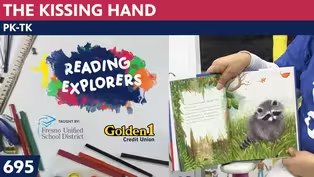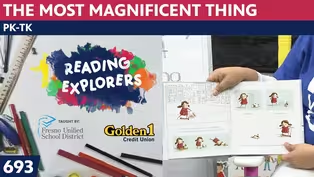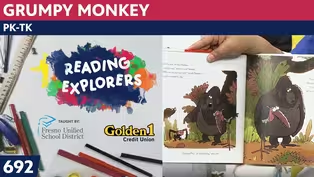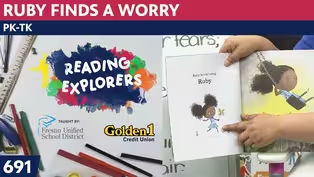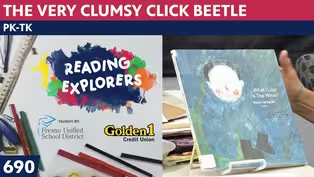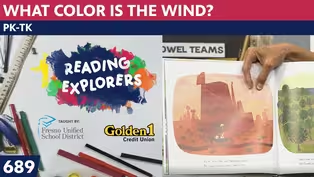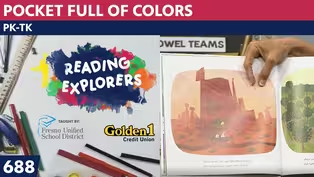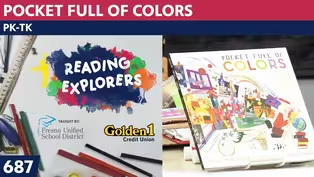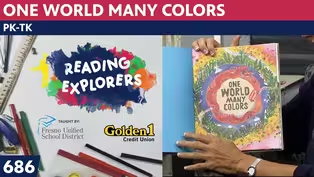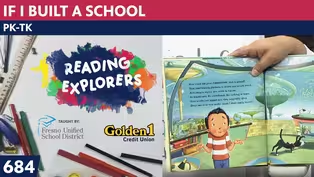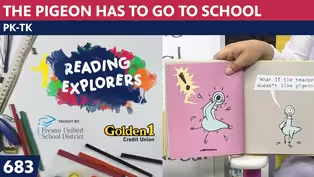
TK-339: Rosalind Monks
Season 3 Episode 210 | 14m 12sVideo has Closed Captions
Join Mrs. Readwright at Camp Discovery!
Transitional Kindergarten teacher, Mrs. Readwright, welcomes students back to Camp Discovery, a fun learning space packed with reading adventures & fun games!
Problems playing video? | Closed Captioning Feedback
Problems playing video? | Closed Captioning Feedback
Reading Explorers is a local public television program presented by Valley PBS

TK-339: Rosalind Monks
Season 3 Episode 210 | 14m 12sVideo has Closed Captions
Transitional Kindergarten teacher, Mrs. Readwright, welcomes students back to Camp Discovery, a fun learning space packed with reading adventures & fun games!
Problems playing video? | Closed Captioning Feedback
How to Watch Reading Explorers
Reading Explorers is available to stream on pbs.org and the free PBS App, available on iPhone, Apple TV, Android TV, Android smartphones, Amazon Fire TV, Amazon Fire Tablet, Roku, Samsung Smart TV, and Vizio.
Providing Support for PBS.org
Learn Moreabout PBS online sponsorshipMore from This Collection
Valley PBS and Fresno Unified School District have partnered with Golden 1 Credit Union to create Reading Explorers Lessons for grades Pre-Kindergarten through Third grade. The daily lessons will be taught by Fresno Unified School District teachers and are created to help students practice their reading skills and reinforce lessons during distance learning.
Video has Closed Captions
Valley PBS presents Reading Explorers Lessons for Pre-Kindergarten and TK. (26m 27s)
PK-TK-693-The Most Magnificent Thing
Video has Closed Captions
Valley PBS presents Reading Explorers Lessons for Pre-Kindergarten and TK. (26m 26s)
Video has Closed Captions
Valley PBS presents Reading Explorers Lessons for Pre-Kindergarten and TK. (26m 28s)
Video has Closed Captions
Valley PBS presents Reading Explorers Lessons for Pre-Kindergarten and TK. (26m 28s)
PK-TK-690: The Very Clumsy Click Beetle
Video has Closed Captions
Valley PBS presents Reading Explorers Lessons for Pre-Kindergarten and TK. (26m 22s)
PK-TK-689: What Color is the Wind?
Video has Closed Captions
Valley PBS presents Reading Explorers Lessons for Pre-Kindergarten and TK. (26m 21s)
PK-TK-688: Pocket Full of Colors
Video has Closed Captions
Valley PBS presents Reading Explorers Lessons for Pre-Kindergarten and TK. (25m 58s)
PK-TK-687: Dancing Through Fields of Colors
Video has Closed Captions
Valley PBS presents Reading Explorers Lessons for Pre-Kindergarten and TK. (26m 20s)
PK-TK-686: One World Many Colors
Video has Closed Captions
Valley PBS presents Reading Explorers Lessons for Pre-Kindergarten and TK. (27m 13s)
PK-TK-685: School is Wherever I am
Video has Closed Captions
Valley PBS presents Reading Explorers Lessons for Pre-Kindergarten and TK. (26m 32s)
PK-TK-684: If I Built a School
Video has Closed Captions
Valley PBS presents Reading Explorers Lessons for Pre-Kindergarten and TK. (26m 21s)
PK-TK-683: The Pigeon Has to Go to School
Video has Closed Captions
Valley PBS presents Reading Explorers Lessons for Pre-Kindergarten and TK. (26m 22s)
Providing Support for PBS.org
Learn Moreabout PBS online sponsorship♪ Good morning to a brand new day ♪ ♪ Time to learn and games you play ♪ ♪ Learning things is so much fun ♪ ♪ Learning is good for everyone ♪ (playful music) - Hello early learners, welcome back to the art room, its me Mrs. Readwright.
Let's start off with our hello song.
♪ Hello nice to see you everyone ♪ ♪ Hello nice to see you everyone ♪ ♪ Hello to you ♪ ♪ Hello to you ♪ ♪ Hello to you ♪ ♪ Hello to me ♪ ♪ Hello nice to see you everyone ♪ You know this week, and this month we're going to be talking about the ABCs of art and we are already on the letter I, I is for insect.
Let's sing our song and then get too busy to meet our artist.
♪ A B C D E of art ♪ ♪ That's the way that we will start ♪ ♪ F is for fish gulf it starts with a G ♪ ♪ H is for house now don't you see ♪ ♪ I is for insect jar starts with J ♪ ♪ Art and the alphabet what do you say ♪ Today We are meeting an artist named Rosalind Monks her friend is color Rosie.
Well Rosie was born in the United Kingdom and she works mostly with black and white.
She uses line and pattern.
And if you remember when we did zentangles a while back we're gonna be filling in the insects wings with zentangles or patterns that repeat themselves.
Now she's inspired by the environment, she spends half of her time in a snowy place and half of her time at the ocean.
She travels around and she captures the beautiful patterns of what she sees around her.
So she says, if her surroundings are beautiful then her artwork is beautiful.
And she says that the more interesting her surroundings are the more she is inspired to do interesting work.
So we have her, inside my mind I have a lot of great patterns and I also brought my old zentangle papers.
So let's take a look at her art and the photograph of her.
Let me turn sideways.
She has an insect.
Now we know insects have six legs so that leaves out the spiders.
It has six legs, it has two, three body parts, so it has an abdomen, a thorax, and a head.
♪ Head, thorax, abdomen ♪ Do you know that song?
Ask your teacher to teach it to you.
But then it has two sets of wings a big set of wings that are the same shape and size, and two lower wings, that are smaller and the same shape and size.
And if you know anything about symmetry, symmetry means whatever you draw on this side you need to draw on that side.
So if this one has big open polka dots, that has big open polka dots.
If this has little mountains with a sunrise, this has mountains and the sunrise.
But does it matter if you don't follow that?
Not really.
If you want to have a symmetrical insect, then do that.
If not, and your insect will look very different from mine even if we do a step-by-step process.
So don't worry about if yours has a really a long abdomen and a little skinny thorax or a pointed head or a rounded head, because you know about art?
What we say about it is that it all can be your own making.
So let me get the table up top.
Oh, I should show you what she looks like.
There she is.
You can tell that she's a current person who's alive now and still living and working around in Europe.
Let me set this down, pick up my table and we'll start our insect drawing.
I brought one blown up so we would have an idea of a simplified one trying to remember in science the parts of an insect.
So let's put this up here and I'm going to ask you the question.
If I'm going to be doing this giant insect with two sets of wings, a head, thorax, abdomen, should I have my paper vertically or shall I set up my paper horizontally?
That's right.
Horizontally will be better because look how wide he is.
You could make yours tiny, but why?
If you have a big paper you're gonna wanna fill your paper up.
But the thing about that is I've been thinking how long will it take me to finish this insect if I make it gigantic?
Well, probably a long time.
But I'm gonna turn him to me so I have the inspiration and then I'll turn it back to you.
I think I'm going to use my skinny black pen unless it doesn't show up very well and then I have my dark black one.
I know that I need to make three body parts, head, thorax, abdomen.
And we know the abdomen is the largest part.
So I'm going to look in the middle and find this.
Now his, the one that I brought is my inspiration.
The antenna go off side to side in a little curve.
So if that's the kind of antenna you want to do then just leave a little space up here, but if you want your antenna to go straight up then you'll have to move your head down.
So I'm gonna start out and I'm going to make my head down here.
And really it's kind of a wide one, like a fly's head.
If you've ever seen a fly when it's at your picnic it's eyes are so gigantic and off to the side.
Do you see what I've done?
I just made my head like this.
It just has curved side,.
it looks like a rectangle that got curved away.
I'm gonna put a little part where it's gonna connect onto its thorax.
I'm going to make the eyeballs stick off to the side like this.
'Cause you know, they have those compound eyes that look like they have a grid of a million little eyeballs.
So I'm curving my lines a little bit, so it looks like it's on a curve shape.
So I'm going to cross mine, do the pattern of the eyes here.
There's my first zentangle is by doing some real compound eye looks.
Now my next part is thorax and I'm going to make it not as big as the abdomen but it's bigger than the head, you do that.
Now we know on this on a lot of insects do have this, they have a pointed abdomen that goes down to a point, some have stingers in it to protect themselves from other predators.
But I think I'm going to do that.
So I look to see how skinny I want his waist to be so I can put it like this, put a dot there and the same distance over there.
I like putting dots so that I know how far to go.
And I'm going to make the tail end there so I can make it bubble out and go there, bubble out and go there.
Remember I've talked to you about first drawing it with your fingers and kind of see the line.
So I'm going to do that, go out, curve in and go to that ending dot.
Yep, pretty good.
Go out, I'm looking how far out I went.
Maybe I wanna go out about that far I put a tiny dot and say, go out that far, touch it, go down to my point.
Hey, pretty good.
I'm gonna give it some stripes like a bumblebee.
I'll put skinny, skinny, skinny, fat, skinny, skinny, fat.
Do you have to do the stripes?
What do you think the answer is?
No, you make your insect that starts with letter I, how you want to.
'Cause who wants it to always look like Mrs. Readwright?
Nobody, and you go back up here and do the antenna, curve line, curve line and how I make it come back in, I make a little mountain at the end, a little mountain at the end, and then I mark a place that I'm gonna come back to how skinny I want it, that skinny.
So then I say, stay away from that line as much as you can keep it as same distance, try and make the line the same line.
Oh, pretty good, Mrs. Readwright.
All right, stay away from that other line, take your time and stop.
Oh, I'm really happy about that.
And I'm gonna put little polka dots down line.
I don't know if any insects have polka dots but this is gonna be fun to have this pattern.
Polka dot, polka dot, polka dot, poke, polka dot, polka dot, polka dot, poke, and remember I'm making mine symmetrical.
So I'm putting whatever I put on that side, I'm putting on this side.
Okay now, to make the wings let me turn it this way and see where I would put my dots.
Since it has six legs, I have to make two legs up here, so I'm gonna put two little places like this to remember not to go too far.
But now below that, I'm gonna put a dot here, I'm going to pretend I'm going to that, everything comes out of the thorax.
The legs come out of the thorax, the wings come out of the thorax.
If you put it on your abdomen, that's not where they go in science.
So I'm gonna remember don't put my wings or legs down on my abdomen, they all go on the thorax.
So I'm gonna go up and it's kind of triangular on the one if you look at hers and go in I think that looks pretty good.
And then down here is my other one go to the thorax.
Don't go there.
Pretty good.
Now let me see how that looks kind of as big as my hand I'll put that over here and start it up.
Go up, look over there, how far out did it go?
Pretty far.
Is it perfect?
No, but do I like it?
You better I do.
There we go.
Okay, I'm gonna put up this leg, it has a leg, a crawling leg part, a middle leg crawling part, and then it's kind of clash, kind of crawling part.
It has walking part, crawling part and the grabbing things part.
Okay, one, two, I need four more.
I can make the legs later but I want to start talking about the patterns on the wings.
So I am going to make a design on the top of my wing.
I am going to make the same thing over here.
A curve line that ends right about there.
And then I can do like triangles if I want you can make anything pattern you want in your shape.
Go down, go down.
You notice I didn't ask you to bring any coloring tools but if you want to paint yours or color yours later, you go right ahead.
I want mine to look like Rosalind Monks, so I'm just gonna do my black and white.
You notice I'm doing this wing then whatever I did they're going next door and doing it over here.
'Cause that part I really want it to do just like a real insect with symmetrical wings.
I'm gonna make a little shape here, and so I have to go over here and make the same shape over here.
Now I'm going to look at my zentangles and think what looks good.
Oh, I know I'll make some little mountains up mountain up, mountain up, mountain up, mountain up.
And I'll put a mountain between, a mountain between, a mountain between, a mountain between, a mountain between, a mountain between.
Boys and girls you know this is letter I, let's see A, B, C, D, E, F, G, H, I, J tomorrow is letter J and we're going to be doing a jar of peaches with Claude Monet.
So I'm bringing gray and black and white paper, I'm even bringing some peach colored paper so I can make my peaches.
I'm bringing all my coloring tools and this is what I'm gonna use a straw again with some white paint the table that they are having us look at on the painting has marble on it.
So I'm going to put, spray my white paint around on there.
So let's say goodbye to one another.
♪ Good bye see you next time everyone ♪ ♪ Good bye see you next time everyone ♪ ♪ Goodbye to you ♪ ♪ Goodbye to you ♪ ♪ Goodbye to you ♪ ♪ Goodbye to me ♪ ♪ Goodbye see you next time everyone ♪ Boys and girls I will see you tomorrow.
Thanks for joining me today, and working with I is for insect.
(upbeat guitar music) ♪ Good morning to a brand new day ♪ ♪ Time to learn and games to play ♪ ♪ Learning things is so much fun ♪ ♪ Learning is good for everyone ♪ (upbeat guitar music)
Support for PBS provided by:
Reading Explorers is a local public television program presented by Valley PBS
